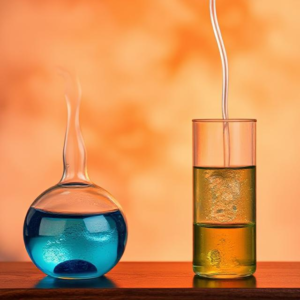What is Dalton’s Law?
Dalton’s Law states that in a mixture of gases, each gas exerts its own pressure independently of the others. The total pressure of the gas mixture is simply the sum of the partial pressures of all the gases present in the mixture. This means that each gas in a mixture behaves as if it is the only gas in the container, and its pressure doesn’t depend on the presence of the other gases.
- In simple terms: If you have more than one gas in a container, each gas pushes on the container walls with its own pressure. The total pressure is the sum of all those individual pressures.

Dalton’s Law Formula:
The formula to calculate the total pressure of a mixture of gases is:
Where:
is the total pressure exerted by the gas mixture.
are the partial pressures of the individual gases in the mixture.
What is Partial Pressure?
The partial pressure of a gas is the pressure that gas would exert if it occupied the entire volume of the container by itself. So, each gas in a mixture has its own partial pressure based on its amount (or mole fraction) and temperature, and these partial pressures add up to give the total pressure.
- In simple terms: The partial pressure of a gas is like the “share” of the total pressure that comes from that specific gas in the mixture.
Understanding Dalton’s Law in Detail:
1. Independent Behavior of Gases:
Each gas in a mixture behaves independently in terms of its pressure. For example:
- If you have a container with oxygen, nitrogen, and carbon dioxide, each of these gases exerts its own pressure.
- The total pressure in the container is just the sum of the pressures exerted by each gas, without interfering with each other.
2. Example of Gases in a Mixture:
Imagine you have a sealed container that contains oxygen (O₂) and nitrogen (N₂). Let’s say:
- The partial pressure of oxygen is 3 atm (atmospheres).
- The partial pressure of nitrogen is 2 atm.
According to Dalton’s Law, the total pressure in the container will be:
So, the total pressure in the container is 5 atm, which is simply the sum of the partial pressures of oxygen and nitrogen.
3. Applications in Real Life:
Dalton’s Law is useful in understanding many real-world phenomena, such as:
- Breathing: The air you breathe is a mixture of gases (mainly nitrogen and oxygen). Each gas has its own pressure, but the total pressure of the air is the sum of all these gases.
- Diving: In scuba diving, the total pressure around you is the sum of the partial pressures of gases in the water and the air in your diving tank. Understanding Dalton’s Law helps divers manage the risks of breathing gases at high pressures, such as nitrogen and oxygen.
- Weather: Atmospheric pressure is the total pressure from all the gases in the air, and Dalton’s Law helps us understand how different gases contribute to weather patterns.
Key Points to Remember:
- Independent Pressure: Each gas in a mixture exerts its own pressure, independent of the other gases.
- Partial Pressure: The partial pressure of each gas is the pressure it would exert if it were the only gas in the container.
- Total Pressure: The total pressure is simply the sum of the partial pressures of all the gases in the mixture.
- Ideal Gas Behavior: Dalton’s Law works best for ideal gases, where the gases don’t interact strongly with each other.
Mathematical Example:
Suppose you have a container with three gases:
- Hydrogen (H₂) with a partial pressure of 2 atm.
- Oxygen (O₂) with a partial pressure of 1 atm.
- Carbon Dioxide (CO₂) with a partial pressure of 0.5 atm.
Using Dalton’s Law, the total pressure in the container would be:
This is the total pressure exerted by the three gases in the mixture.
Conclusion:
- Dalton’s Law of Partial Pressures helps us understand how gases behave in mixtures.
- The total pressure is just the sum of the partial pressures of each gas in the mixture, and each gas behaves independently in terms of pressure.
- This law is used in many scientific fields, such as chemistry, physics, and medicine, to predict how gases will behave under different conditions.
Tags: additive pressure principle, air composition, atmospheric pressure, breathing mechanism, carbon dioxide, Dalton's Law, diving physics, gas behavior, gas combination, gas container, gas law example, gas laws, gas mixture, ideal gas, ideal gas assumption, independent gas behavior, individual gas pressure, medical gas mixtures, mole fraction, nitrogen, oxygen, partial pressure, partial pressure definition, physics of gases., pressure calculation, pressure formula, pressure in mixtures, pressure units (atm), Ptotal = P1 + P2 + P3, real-world applications., scuba diving, sealed container, sum of pressures, total pressure, total pressure formula, volume and temperature, weather pressure


